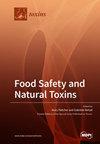蓝藻环肽能破坏人类星形胶质细胞的细胞骨架组织--对理解蓝藻毒素的全身毒性的贡献
IF 3.9
3区 医学
Q2 FOOD SCIENCE & TECHNOLOGY
引用次数: 0
摘要
蓝藻(CCP)产生的环肽的全身毒性尚未完全明了。除了已知的对肝脏和肾脏的损害外,也有关于其神经毒性症状的报道。肝毒性 CCPs(如微囊藻毒素)以及非肝毒性的anabaenopeptins 和 planktopeptins 都会对哺乳动物细胞产生细胞毒性和细胞抑制作用。然而,不同类型细胞对 CCPs 的反应取决于它们与细胞膜相互作用的特定模式。本研究表明,非肝脏毒性的板蓝根肽 BL1125 和anabaenopeptins B 和 F(浓度高达 10 µM)通过几乎立即插入脂质单层,在体外对正常和肿瘤人类星形胶质细胞(NHA 和 U87-GM)产生影响。与微囊藻毒素-LR(最高 1 µM)一样,它们也会抑制 Ser/Thr 磷酸酶并重组细胞骨架元素,但对其基因表达的影响不大。根据观察到的对中间丝和中间丝连接元件的影响,以及它们通过翻译后修饰对微管蛋白细胞骨架的直接或间接影响,我们得出结论,CCP 毒性的基本机制是诱导细胞间和细胞内的通讯失效。由于信号转导级联受磷酸化/去磷酸化过程的调节,因此评估对 Ser/Thr 磷酸酶的抑制活性也至关重要。本文章由计算机程序翻译,如有差异,请以英文原文为准。
Cyanobacterial Cyclic Peptides Can Disrupt Cytoskeleton Organization in Human Astrocytes—A Contribution to the Understanding of the Systemic Toxicity of Cyanotoxins
The systemic toxicity of cyclic peptides produced by cyanobacteria (CCPs) is not yet completely understood. Apart from the most known damages to the liver and kidneys, symptoms of their neurotoxicity have also been reported. Hepatotoxic CCPs, like microcystins, as well as non-hepatotoxic anabaenopeptins and planktopeptins, all exhibit cytotoxic and cytostatic effects on mammalian cells. However, responses of different cell types to CCPs depend on their specific modes of interaction with cell membranes. This study demonstrates that non-hepatotoxic planktopeptin BL1125 and anabaenopeptins B and F, at concentrations up to 10 µM, affect normal and tumor human astrocytes (NHA and U87-GM) in vitro by their almost immediate insertion into the lipid monolayer. Like microcystin-LR (up to 1 µM), they inhibit Ser/Thr phosphatases and reorganize cytoskeletal elements, with modest effects on their gene expression. Based on the observed effects on intermediate filaments and intermediate filament linkage elements, their direct or indirect influence on tubulin cytoskeletons via post-translational modifications, we conclude that the basic mechanism of CCP toxicities is the induction of inter- and intracellular communication failure. The assessed inhibitory activity on Ser/Thr phosphatases is also crucial since the signal transduction cascades are modulated by phosphorylation/dephosphorylation processes.
求助全文
通过发布文献求助,成功后即可免费获取论文全文。
去求助
来源期刊

Toxins
TOXICOLOGY-
CiteScore
7.50
自引率
16.70%
发文量
765
审稿时长
16.24 days
期刊介绍:
Toxins (ISSN 2072-6651) is an international, peer-reviewed open access journal which provides an advanced forum for studies related to toxins and toxinology. It publishes reviews, regular research papers and short communications. Our aim is to encourage scientists to publish their experimental and theoretical results in as much detail as possible. There is no restriction on the length of the papers. The full experimental details must be provided so that the results can be reproduced.
 求助内容:
求助内容: 应助结果提醒方式:
应助结果提醒方式:


